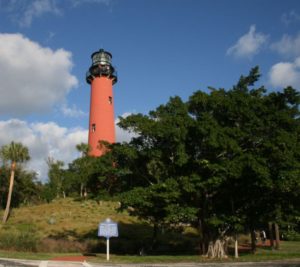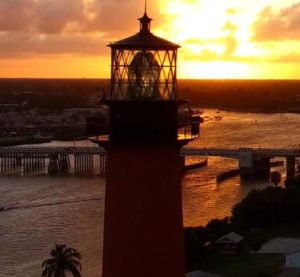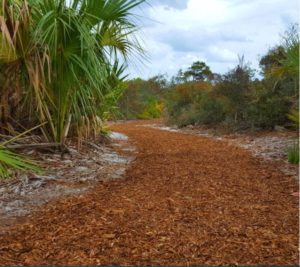The Jupiter Inlet Lighthouse that faithfully shines out to sea each night in Jupiter, Florida has long been in need of restoration.
 Rusted areas on the cast iron roof plates are deteriorating rapidly due to weathering and need repair to preserve the integrity of the structure and keep the 1860 lighthouse tower and rare First Order Fresnel Lens waterproof. Protection from water intrusion is top priority for the historic Lighthouse.
Rusted areas on the cast iron roof plates are deteriorating rapidly due to weathering and need repair to preserve the integrity of the structure and keep the 1860 lighthouse tower and rare First Order Fresnel Lens waterproof. Protection from water intrusion is top priority for the historic Lighthouse.
With permission from the US Coast Guard, the Jupiter Light was turned off in the month of May in order to wrap the lens and build a special encasement to protect the First Order Lens during the work on the roof.
On June 2, 2017, the light came back on, shining from a newly-restored community asset. Donors to the restoration fund were invited to a special Re-Light the Light countdown party.
Preservation work also included repairs to the cupola and watch room door, and the installation of a safety handrail at the top of the spiral staircase for easier entry into the watch room. An “A Team” of Lighthouse experts was assembled for the project. Experienced lighthouse preservationists include historic architect Ken Smith from Ken Smith Architects in Jacksonville, Florida, lens conservationist Joe Cocking from Lighthouse Lamp Shop, metalsmith expert Alex Klahm from Architectural Metal and Design, and Anthony Houllis from Razorback LLC in Tarpon Springs, Florida.
“These historic preservation professionals have restored many of the lighthouses in Florida and around the country. Ken Smith, Alex Klahm and Anthony Houllis just recently restored the Gasparilla Light in Boca Grande. Joe Cocking restored the Jupiter Light lens in 2,000 and has served as our lens specialist for the past 17 years,” says Jamie Stuve, President & CEO of the Loxahatchee River Historical Society (LRHS). “We honestly feel this is the best condition this lighthouse has been in since it was built,” she continued.
 There is a meticulous process that must be followed in caring for the iconic Light. The paint on the roof and cupola will be removed to bare metal, and then repairs to the roof plates and seams can be made. Finally the roof will receive a marine zinc primer and coats of long-lasting, high grade black paint. This required encapsulating the paint as it is removed. Special equipment such as scaffolding was used for workers to access the top of the Lighthouse.
There is a meticulous process that must be followed in caring for the iconic Light. The paint on the roof and cupola will be removed to bare metal, and then repairs to the roof plates and seams can be made. Finally the roof will receive a marine zinc primer and coats of long-lasting, high grade black paint. This required encapsulating the paint as it is removed. Special equipment such as scaffolding was used for workers to access the top of the Lighthouse.
Additionally, all the metal paint was be prepped and repainted, including the gallery deck (where visitors walk around the top), door, railings, catwalk and triangular astragal frames surrounding the weather glass. The masonry beneath the gallery deck will also be painted. Other minor repairs will be made prior to painting.
Contractor Anthony Houllis is one of few people with the skills to do this. “I understand the history and the meaning that these lighthouses have in their communities,” he explained. “It’s a lot more brittle,” said Houllis. “Where steel will bend, the iron will tend to break rather than bend. So, you definitely have to be cautious and experienced with it.”
The lighthouse tower was closed for climbing during the month of May during the project, however, visitors still had the opportunity to see the brand-new exhibit Keeping the Light at Jupiter Inlet: Adventures in the Lives of Lighthouse Keepers, in the Lighthouse Keepers Workshop.
 The restoration coincides with the opening of the new Jilona Trail around the lighthouse grounds.
The restoration coincides with the opening of the new Jilona Trail around the lighthouse grounds.
On May 8th, 2017, local residents joined the Bureau of Land Management at the Jupiter Inlet Lighthouse Outstanding Natural Area (ONA) to explore the site’s newest trail. The trail is a 1-mile loop that circles through scrub and hammock plant communities behind the landmark Jupiter Inlet Lighthouse. BLM staff gave guided tours of the trail.
The Loxahatchee River Historical Society, the nonprofit that operates the Jupiter Inlet Lighthouse & Museum, was awarded many grants and donations towards the $152,000 project. These include $40,000 from the Bureau of Land Management, $25,400 from the Loxahatchee Guild, $6,000 from individual donations and a pending $30,000 grant from the Florida Lighthouse Association. The Historical Society received donations from the community to cover the remaining needs.
The Florida Lighthouse Association’s (FLA) mission is to safeguard Florida’s remaining lighthouses for future generations by supporting community based restoration, preservation and education efforts. Florida’s maritime heritage is central to understanding Florida’s culture and way of life. Lighthouses played a critical role in Florida’s history; making it possible to explore, settle and develop Florida by using its 1350 miles of coastline. They are too important to be destroyed by neglect.
All photos courtesy of Jupiter Inlet Lighthouse & Museum.
See Jupiter Inlet Lighthouse website.
See Florida Lighthouse Association’s restoration grants page.

